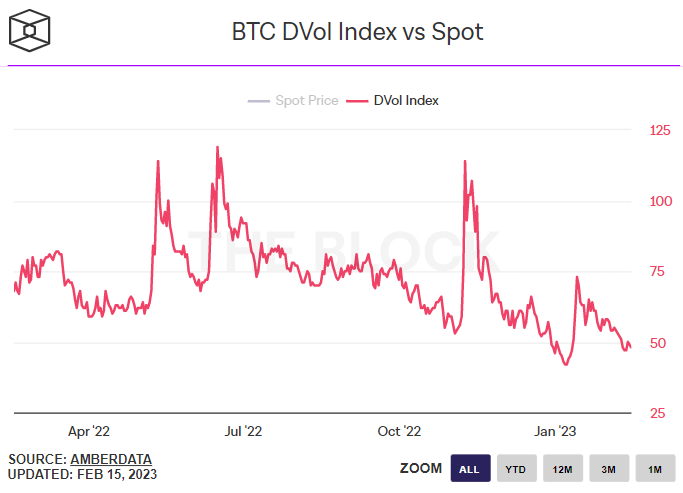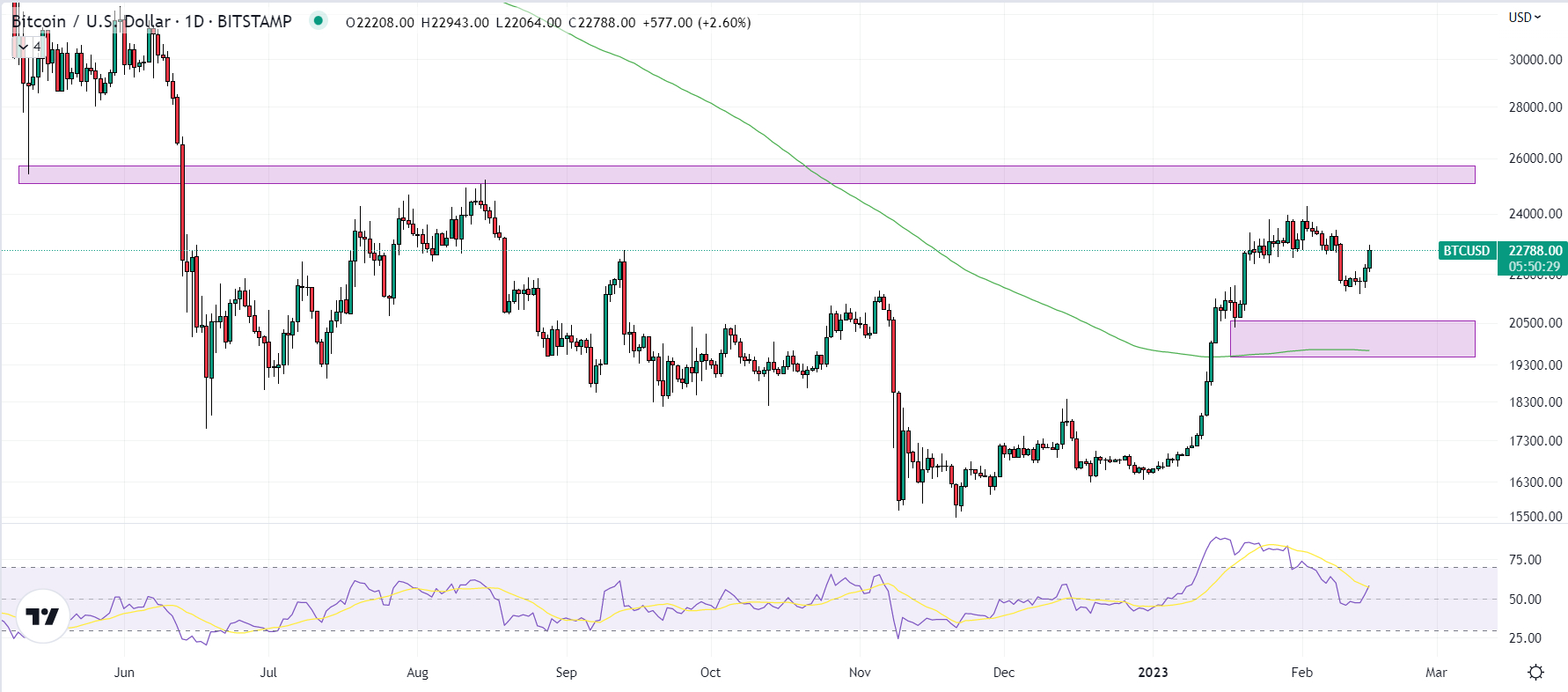In wake of Tuesday’s US Consumer Price Index (CPI) data, which confirmed an expected jump in MoM price pressures and revealed a smaller-than-expected decline in the YoY rate of inflation, Deribit’s Bitcoin Volatility Index (BTC DVol) surprised some analysts by remaining broadly unchanged. The lack of movement in the BTC DVol, which was last at 48 on Wednesday versus 50 on Monday and remains not far above record lows, matches the post-CPI mood seen in the Bitcoin market.

Bitcoin, last changing hands around $22,800, has rallied about $1,000 or 4.5% from its pre-US CPI data levels on Tuesday and is up around 4.7% on the week. That’s despite Tuesday’s CPI data and stronger-than-expected US Retail Sales data on Wednesday combining to push US 2-year yields around 10 bps so far this week, and the US Dollar Index (DXY) up around 0.5%.
The move’s in US bond and currency markets reflect markets upping their US Federal Reserve tightening bets. According to the CME’s Fed Watch Tool, the odds of the Fed raising interest rates by at least 75 bps (to at least a 5.25-5.50% target range) are now seen at above 50%, as implied by 30-Day Fed Funds futures pricing data. That’s up from an implied probability of only around 6.0% this time last month.

Bitcoin’s Surprising Resilience
Given moves across bond and currency markets, many analysts are shocked at Bitcoin’s resilience. Higher yields typically weigh on Bitcoin as 1) Bitcoin is a non-yielding asset, so the so-called “opportunity cost” of holding it rises as short-term US interest rates rise and 2) higher yields on US bonds, an asset that is considered risk-free, decreases the incentive to hold assets that are considered risky, like Bitcoin, which many view as a new, speculative financial technology.
Meanwhile, when higher short-term yields are being driven by anticipation of tighter Fed policy, then that can also be interpreted as higher risks of weaker US growth/a recession, as higher interest rates weigh on economic activity. Weaker growth expectations can normally be assumed to hurt risk-sensitive assets like stocks and crypto.
But Bitcoin is nonetheless still holding onto the lion’s share of 2023’s rally. The cryptocurrency still trades up around 38% this year versus 47% when at its early February highs around $24,000. And, as already noted, options markets are not pointing to stormy waters ahead. On the contrary, the BTC DVol has only printed at current or lower levels 11 times in Bitcoin’s history, suggesting investors are positioned for an incoming period of historic price calm.

What This Means For the BTC Price
If options markets are right, Bitcoin is likely to remain rangebound in the coming weeks and months. Analysis of major support and resistance levels suggests that Bitcoin could remain marooned within a $20,000-$25,000 range. The $20,000 level is important because of its psychological significance and the presence of Bitcoin’s 200-Day Moving Average and Realized Price just below it. The $25,000 level, meanwhile, is an important level of support-turned-resistance from 2022.

For Bitcoin to remain rangebound in the coming months makes sense when considering macro, on-chain and network fundamentals. On the one hand, arguing for a continuation of January’s ferocious rally and a surge to fresh all-time highs in the short term is unrealistic in the context of a Fed that remains intent on hiking interest rates at least a few more times to tame US price pressures.
On the other hand, various metrics continue to signal the inexorable growth of the Bitcoin network — mining hash power and non-zero balance wallet addresses both recently hit all-time highs. Meanwhile, various on-chain indicators are also signaling that the bear market of 2022 appears to be over. Just as a rally towards all-time highs feels unlikely, a breakout under 2022’s lows also feels improbable.
In wake of Tuesday’s US Consumer Price Index (CPI) data, which confirmed an expected jump in MoM price pressures and revealed a smaller-than-expected decline in the YoY rate of inflation, Deribit’s Bitcoin Volatility Index (BTC DVol) surprised some analysts by remaining broadly unchanged. The lack of movement in the BTC DVol, which was last at 48 on Wednesday versus 50 on Monday and remains not far above record lows, matches the post-CPI mood seen in the Bitcoin market.

Bitcoin, last changing hands around $22,800, has rallied about $1,000 or 4.5% from its pre-US CPI data levels on Tuesday and is up around 4.7% on the week. That’s despite Tuesday’s CPI data and stronger-than-expected US Retail Sales data on Wednesday combining to push US 2-year yields around 10 bps so far this week, and the US Dollar Index (DXY) up around 0.5%.
The move’s in US bond and currency markets reflect markets upping their US Federal Reserve tightening bets. According to the CME’s Fed Watch Tool, the odds of the Fed raising interest rates by at least 75 bps (to at least a 5.25-5.50% target range) are now seen at above 50%, as implied by 30-Day Fed Funds futures pricing data. That’s up from an implied probability of only around 6.0% this time last month.

Bitcoin’s Surprising Resilience
Given moves across bond and currency markets, many analysts are shocked at Bitcoin’s resilience. Higher yields typically weigh on Bitcoin as 1) Bitcoin is a non-yielding asset, so the so-called “opportunity cost” of holding it rises as short-term US interest rates rise and 2) higher yields on US bonds, an asset that is considered risk-free, decreases the incentive to hold assets that are considered risky, like Bitcoin, which many view as a new, speculative financial technology.
Meanwhile, when higher short-term yields are being driven by anticipation of tighter Fed policy, then that can also be interpreted as higher risks of weaker US growth/a recession, as higher interest rates weigh on economic activity. Weaker growth expectations can normally be assumed to hurt risk-sensitive assets like stocks and crypto.
But Bitcoin is nonetheless still holding onto the lion’s share of 2023’s rally. The cryptocurrency still trades up around 38% this year versus 47% when at its early February highs around $24,000. And, as already noted, options markets are not pointing to stormy waters ahead. On the contrary, the BTC DVol has only printed at current or lower levels 11 times in Bitcoin’s history, suggesting investors are positioned for an incoming period of historic price calm.

What This Means For the BTC Price
If options markets are right, Bitcoin is likely to remain rangebound in the coming weeks and months. Analysis of major support and resistance levels suggests that Bitcoin could remain marooned within a $20,000-$25,000 range. The $20,000 level is important because of its psychological significance and the presence of Bitcoin’s 200-Day Moving Average and Realized Price just below it. The $25,000 level, meanwhile, is an important level of support-turned-resistance from 2022.

For Bitcoin to remain rangebound in the coming months makes sense when considering macro, on-chain and network fundamentals. On the one hand, arguing for a continuation of January’s ferocious rally and a surge to fresh all-time highs in the short term is unrealistic in the context of a Fed that remains intent on hiking interest rates at least a few more times to tame US price pressures.
On the other hand, various metrics continue to signal the inexorable growth of the Bitcoin network — mining hash power and non-zero balance wallet addresses both recently hit all-time highs. Meanwhile, various on-chain indicators are also signaling that the bear market of 2022 appears to be over. Just as a rally towards all-time highs feels unlikely, a breakout under 2022’s lows also feels improbable.